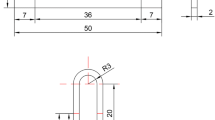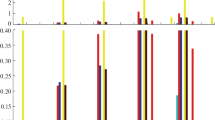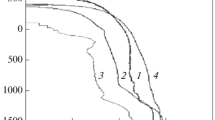Abstract
To study the accumulation and the histological effects in mice organs caused by hexavalent chromium, one of the corrosion products released from AISI 316L stainless steel implants, mice groups were subcutaneously injected with a metallic solution of chromium during a certain period of time. Similar injections were made with HBSS (Hank's Balanced Salt Solution) in other groups to be used as controls. The levels of chromium found in the liver, kidney and spleen of the control and the treated animals were obtained by atomic absorption spectrometry (AAS) and were compared to those obtained by AdSV (adsorptive stripping voltammetry) to test the accuracy of the results. During the experimental period, the liver and spleen showed a progressive and significant accumulation of chromium whereas in the kidney the significant accumulation found after the first week practically remained unchanged during the four weeks. Apparently, the histological analysis of these tissues did not evidence any relevant morphological alteration induced by the chromium accumulations during the four weeks of treatment.
Similar content being viewed by others
References
Bartolozzi A, Black J. 1985 Chromium concentrations in serum, blood clot and urine from patients following total hip arthroplasty. Biomaterials 6, 2-8.
Black J, Maitin EC, Gelman H, Morris DM. 1983 Serum concentrations of chromium, cobalt and nickel after total hip replacement: a six month study. Biomaterials 4, 160-164.
Brien WW, Salvati EA, Healey JH, Bansal M, Ghelman B, Betts F. 1990 Osteogenic sarcoma arising in the area of a total hip replacement. J Bone Joint Surg 72-A, 1097-1099.
Brown SA, Farnsworth LJ, Merritt K, Crowe TD. 1988 In vitro and in vivo metal ion release. J Biomed Mater Res 22, 321-338.
Brown SA, Zhang K, Merritt K, Payer JH. 1993 In vivo transport and excretion of corrosion products from accelerated anodic corrosion of porous coated F75 alloy. J Biomed Mater Res 27, 1007-1017.
Burrows D. 1983 Chromium: Metabolism and Toxicity, CRC Press, Boca Raton, Florida.
Dobbs HS, Minski MJ. 1980 Metal ion release after total hip replacement. Biomaterials 1, 193-198.
Kargacin B, Squibb KS, Cosentino S, Zhitkovich A, Costa M. 1993 Comparison of the uptake and distribution of chromate in rats and mice. Biol Trace Element Res 36, 307-318.
Katz SA, Salem H. 1993 The toxicology of chromium with respect to its chemical speciation: a review. J Appl Toxicol 13, 217-224.
Katz SA, Salem H. 1994 The Biological and Environmental Chemistry of Chromium, VCH Publishers.
Langard S, Hensten-Pettersen A. 1981 Chromium toxicology. In: Williams DF. eds. Systemic Aspects of Biocompatibility. Boca Raton, Florida, CRC Press, 143.
Martin A, Bauer TW, Manley MT, Marks KE. 1988 Osteosarcoma at the site of total hip replacement. J Bone Joint Surg 70-A, 1561-1566.
Merritt K, Brown SA. 1985 Biological effects of corrosion products from metals. In: Fraker AC. Griffin CD. eds. Corrosion and Degradation of Implant Materials: Second Symposium. Philadelphia, American Society for Testing and Materials, 195-207.
Merritt K, Brown SA. 1995 Release of hexavalent chromium from corrosion of stainless steel and cobalt-chromium alloys. J Biomed Mater Res 29, 627-633.
Merritt K, Brown SA, Sharkey NA. 1984 Blood distribution of nickel, cobalt, and chromium following intramuscular injection into hamsters. J Biomed Mater Res 18, 991-1004.
Merritt K, Brown SA, Sharkey NA. 1984 The binding of metal salts and corrosion products to cells and proteins in vitro. J Biomed Mater Res 18, 1005-1015.
Merritt K, Crowe TD, Brown SA. 1989 Elimination of nickel, cobalt, and chromium following repeated injections of high dose metal salts. J Biomed Mater Res 23, 845-862.
Merritt K, Fedele CD, Brown SA. 1992 Chromium 6+ or 3+ release during corrosion; and in vivo distribution. In: Doherty PJ. et al., eds. Biomaterial-Tissue Interfaces, Advances in Biomaterials 10, 49-53.
Pereira MC, Faria JL, Reis ML, Sousa JP. 1997a Nickel quantification in mice organs by adsorptive cathodic stripping voltammetry using microelectrodes. Electroanalysis 9, 150-154.
Pereira MC, Pereira ML, Sousa JP. 1997b Adsorptive stripping voltammetric measurements of chromium accumulation in mice organs using mercury film microelectrodes. Electroanalysis 9, 941-944.
Pereira MC, Pereira ML, Sousa JP. 1998a Evaluation of nickel toxicity on liver, spleen and kidney of mice after administration of high-dose metal ion. J Biomed Mater Res 40, 40-47.
Pereira MC, Pereira ML, Sousa JP. 1998b Adsorptive stripping measurements of iron accumulation in mice kidney using microlectrodes and histological features. J Trace Elements Med Biol 12, 50-55.
Pohler OEM. 1983 Degradation of metallic orthopedic implants. In: Rubin LR, ed. Biomaterials in Reconstructive Surgery, The C.V. Mosby Company; 158-228.
Ross MH, Rowrell LJ. 1985 Histology a Text and Atlas, Williams & Wilkins.
Smith GK, Black J. 1985 Estimation of in vivo type 316L stainless steel corrosion rate from blood transport and organ accumulation data. In: Fraker AC. Griffin CD, eds. Corrosion and Degradation of Implant Materials; Second Symposium, American Philadelphia, Society for Testing and Materials; 223-247.
Sunderman Jr FW, Hopfer SM, Swift T et al. 1989 Cobalt, chromium, and nickel concentrations in body fluids of patients with porous-coated knee or hip prostheses. J Orthop Res 7, 307-315.
Yang J, Black J. 1994 Competitive binding of chromium, cobalt and nickel to serum proteins. Biomaterials 15, 262-268.
Young E, Houwing RH. 1987 Patch test results with standard allergens over a decade. Contact Dermatitis 17, 104-107.
Author information
Authors and Affiliations
Rights and permissions
About this article
Cite this article
Carmo Pereira, M.d., de Lourdes Pereira, M. & Sousa, J.P. Individual study of chromium in the stainless steel implants degradation: An experimental study in mice. Biometals 12, 277–282 (1999). https://doi.org/10.1023/A:1009249700719
Issue Date:
DOI: https://doi.org/10.1023/A:1009249700719




